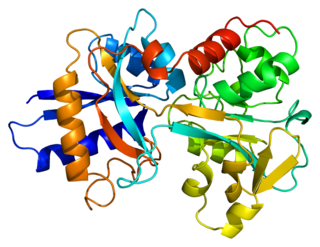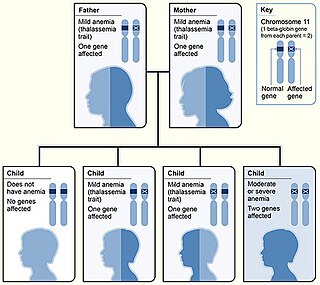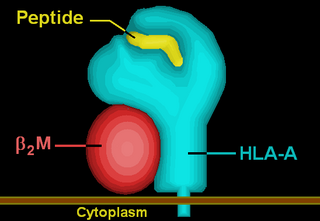Human homeostatic iron regulator protein, also known as the HFE protein (High FE2+), is a transmembrane protein that in humans is encoded by the HFE gene. The HFE gene is located on short arm of chromosome 6 at location 6p22.2 [5]
Human homeostatic iron regulator protein, also known as the HFE protein (High FE2+), is a transmembrane protein that in humans is encoded by the HFE gene. The HFE gene is located on short arm of chromosome 6 at location 6p22.2 [5]
The protein encoded by this gene is an integral membrane protein that is similar to MHC class I-type proteins and associates with beta-2 microglobulin (beta2M). It is thought that this protein functions to regulate circulating iron uptake by regulating the interaction of the transferrin receptor with transferrin. [6]
The HFE gene contains 7 exons spanning 12 kb. [7] The full-length transcript represents 6 exons. [8]
HFE protein is composed of 343 amino acids. There are several components, in sequence: a signal peptide (initial part of the protein), an extracellular transferrin receptor-binding region (α1 and α2), a portion that resembles immunoglobulin molecules (α3), a transmembrane region that anchors the protein in the cell membrane, and a short cytoplasmic tail. [7]
HFE expression is subjected to alternative splicing. The predominant HFE full-length transcript has ~4.2 kb. [9] Alternative HFE splicing variants may serve as iron regulatory mechanisms in specific cells or tissues. [9]
HFE is prominent in small intestinal absorptive cells, [10] [11] gastric epithelial cells, tissue macrophages, and blood monocytes and granulocytes, [11] [12] and the syncytiotrophoblast, an iron transport tissue in the placenta. [13]
The iron storage disorder hereditary hemochromatosis (HHC) is an autosomal recessive genetic disorder that usually results from defects in this gene.
The disease-causing genetic variant most commonly associated with hemochromatosis is p. C282Y. [14] About 1/200 of people of Northern European origin have two copies of this variant; they, particularly males, are at high risk of developing hemochromatosis. [15] This variant may also be one of the factors modifying Wilson's disease phenotype, making the symptoms of the disease appear earlier. [16]
Allele frequencies of HFE C282Y in ethnically diverse western European white populations are 5-14% [17] [18] and in North American non-Hispanic whites are 6-7%. [19] C282Y exists as a polymorphism only in Western European white and derivative populations, although C282Y may have arisen independently in non-whites outside Europe. [20]
HFE H63D is cosmopolitan but occurs with greatest frequency in individuals of European descent. [21] [22] Allele frequencies of H63D in ethnically diverse western European populations are 10-29%. [23] and in North American non-Hispanic whites are 14-15%. [24]
At least 42 mutations involving HFE introns and exons have been discovered, most of them in persons with hemochromatosis or their family members. [25] Most of these mutations are rare. Many of the mutations cause or probably cause hemochromatosis phenotypes, often in compound heterozygosity with HFE C282Y. Other mutations are either synonymous or their effect on iron phenotypes, if any, has not been demonstrated. [25]
The HFE protein interacts with the transferrin receptor TFRC. [26] [27] Its primary mode of action is the regulation of the iron storage hormone hepcidin. [28]
It is possible to delete part or all of a gene of interest in mice (or other experimental animals) as a means of studying function of the gene and its protein. Such mice are called “knockouts” with respect to the deleted gene. Hfe is the mouse equivalent of the human hemochromatosis gene HFE. The protein encoded by HFE is Hfe. Mice homozygous (two abnormal gene copies) for a targeted knockout of all six transcribed Hfe exons are designated Hfe−/−. [29] Iron-related traits of Hfe−/− mice, including increased iron absorption and hepatic iron loading, are inherited in an autosomal recessive pattern. Thus, the Hfe−/− mouse model simulates important genetic and physiological abnormalities of HFE hemochromatosis. [29] Other knockout mice were created to delete the second and third HFE exons (corresponding to α1 and α2 domains of Hfe). Mice homozygous for this deletion also had increased duodenal iron absorption, elevated plasma iron and transferrin saturation levels, and iron overload, mainly in hepatocytes. [30] Mice have also been created that are homozygous for a missense mutation in Hfe (C282Y). These mice correspond to humans with hemochromatosis who are homozygous for HFE C282Y. These mice develop iron loading that is less severe than that of Hfe−/− mice. [31]
The black rhinoceros (Diceros bicornis) can develop iron overload. To determine whether the HFE gene of black rhinoceroses has undergone mutation as an adaptive mechanism to improve iron absorption from iron-poor diets, Beutler et al. sequenced the entire HFE coding region of four species of rhinoceros (two browsing and two grazing species). Although HFE was well conserved across the species, numerous nucleotide differences were found between rhinoceros and human or mouse, some of which changed deduced amino acids. Only one allele, p.S88T in the black rhinoceros, was a candidate that might adversely affect HFE function. p.S88T occurs in a highly conserved region involved in the interaction of HFE and TfR1. [32]
The 2015 version of this article was updated by an external expert under a dual publication model. The corresponding academic peer reviewed article was published in Gene and can be cited as: James C Barton; Corwin Q Edwards; Ronald T Acton (9 October 2015). "HFE gene: Structure, function, mutations, and associated iron abnormalities". Gene . Gene Wiki Review Series. 574 (2): 179–192. doi:10.1016/J.GENE.2015.10.009. ISSN 0378-1119. PMC 6660136 . PMID 26456104. Wikidata Q30380172. |

Hereditary haemochromatosis type 1 is a genetic disorder characterized by excessive intestinal absorption of dietary iron, resulting in a pathological increase in total body iron stores. Humans, like most animals, have no mechanism to regulate excess iron, simply losing a limited amount through various means like sweating or menstruating.

Ferritin is a universal intracellular protein that stores iron and releases it in a controlled fashion. The protein is produced by almost all living organisms, including archaea, bacteria, algae, higher plants, and animals. It is the primary intracellular iron-storage protein in both prokaryotes and eukaryotes, keeping iron in a soluble and non-toxic form. In humans, it acts as a buffer against iron deficiency and iron overload.

Transferrins are glycoproteins found in vertebrates which bind and consequently mediate the transport of iron (Fe) through blood plasma. They are produced in the liver and contain binding sites for two Fe3+ ions. Human transferrin is encoded by the TF gene and produced as a 76 kDa glycoprotein.

Iron overload or haemochromatosis indicates increased total accumulation of iron in the body from any cause and resulting organ damage. The most important causes are hereditary haemochromatosis, a genetic disorder, and transfusional iron overload, which can result from repeated blood transfusions.

Human iron metabolism is the set of chemical reactions that maintain human homeostasis of iron at the systemic and cellular level. Iron is both necessary to the body and potentially toxic. Controlling iron levels in the body is a critically important part of many aspects of human health and disease. Hematologists have been especially interested in systemic iron metabolism, because iron is essential for red blood cells, where most of the human body's iron is contained. Understanding iron metabolism is also important for understanding diseases of iron overload, such as hereditary hemochromatosis, and iron deficiency, such as iron-deficiency anemia.

Hepcidin is a protein that in humans is encoded by the HAMP gene. Hepcidin is a key regulator of the entry of iron into the circulation in mammals.

Ferroportin-1, also known as solute carrier family 40 member 1 (SLC40A1) or iron-regulated transporter 1 (IREG1), is a protein that in humans is encoded by the SLC40A1 gene. Ferroportin is a transmembrane protein that transports iron from the inside of a cell to the outside of the cell. Ferroportin is the only known iron exporter.

African iron overload is an iron overload disorder first observed among people of African descent in Southern Africa and Central Africa. It is now recognized to actually be two disorders with different causes, possibly compounding each other:

Beta thalassemias are a group of inherited blood disorders. They are forms of thalassemia caused by reduced or absent synthesis of the beta chains of hemoglobin that result in variable outcomes ranging from severe anemia to clinically asymptomatic individuals. Global annual incidence is estimated at one in 100,000. Beta thalassemias occur due to malfunctions in the hemoglobin subunit beta or HBB. The severity of the disease depends on the nature of the mutation.

Hemojuvelin (HJV), also known as repulsive guidance molecule C (RGMc) or hemochromatosis type 2 protein (HFE2), is a membrane-bound and soluble protein in mammals that is responsible for the iron overload condition known as juvenile hemochromatosis in humans, a severe form of hemochromatosis. In humans, the hemojuvelin protein is encoded by the HFE2 gene. Hemojuvelin is a member of the repulsive guidance molecule family of proteins. Both RGMa and RGMb are found in the nervous system, while hemojuvelin is found in skeletal muscle and the liver.
In medical genetics, compound heterozygosity is the condition of having two or more heterogeneous recessive alleles at a particular locus that can cause genetic disease in a heterozygous state; that is, an organism is a compound heterozygote when it has two recessive alleles for the same gene, but with those two alleles being different from each other. Compound heterozygosity reflects the diversity of the mutation base for many autosomal recessive genetic disorders; mutations in most disease-causing genes have arisen many times. This means that many cases of disease arise in individuals who have two unrelated alleles, who technically are heterozygotes, but both the alleles are defective.

Atransferrinemia is an autosomal recessive metabolic disorder in which there is an absence of transferrin, a plasma protein that transports iron through the blood. Atransferrinemia is characterized by anemia and hemosiderosis in the heart and liver. The iron damage to the heart can lead to heart failure. The anemia is typically microcytic and hypochromic. Atransferrinemia was first described in 1961 and is extremely rare, with only ten documented cases worldwide.

Transferrin receptor (TfR) is a carrier protein for transferrin. It is needed for the import of iron into cells and is regulated in response to intracellular iron concentration. It imports iron by internalizing the transferrin-iron complex through receptor-mediated endocytosis. The existence of a receptor for transferrin iron uptake has been recognized since the late 1950s. Earlier two transferrin receptors in humans, transferrin receptor 1 and transferrin receptor 2 had been characterized and until recently cellular iron uptake was believed to occur chiefly via these two well documented transferrin receptors. Both these receptors are transmembrane glycoproteins. TfR1 is a high affinity ubiquitously expressed receptor while expression of TfR2 is restricted to certain cell types and is unaffected by intracellular iron concentrations. TfR2 binds to transferrin with a 25-30 fold lower affinity than TfR1. Although TfR1 mediated iron uptake is the major pathway for iron acquisition by most cells and especially developing erythrocytes, several studies have indicated that the uptake mechanism varies depending upon the cell type. It is also reported that Tf uptake exists independent of these TfRs although the mechanisms are not well characterized. The multifunctional glycolytic enzyme glyceraldehyde 3-phosphate dehydrogenase has been shown to utilize post translational modifications to exhibit higher order moonlighting behavior wherein it switches its function as a holo or apo transferrin receptor leading to either iron delivery or iron export respectively.

HLA-A3 (A3) is a human leukocyte antigen serotype within HLA-A serotype group. The serotype is determined by the antibody recognition of α3 subset of HLA-A α-chains. For A3, the alpha, "A", chain are encoded by the HLA-A*03 allele group and the β-chain are encoded by B2M locus. This group currently is dominated by A*03:01. A3 and A*03 are almost synonymous in meaning. A3 is more common in Europe, it is part of the longest known multigene haplotype, A3~B7~DR15~DQ6.

Transferrin receptor 2 (TfR2) is a protein that in humans is encoded by the TFR2 gene. This protein is involved in the uptake of transferrin-bound iron into cells by endocytosis, although its role is minor compared to transferrin receptor 1.

Transferrin receptor protein 1 (TfR1), also known as Cluster of Differentiation 71 (CD71), is a protein that in humans is encoded by the TFRC gene. TfR1 is required for iron import from transferrin into cells by endocytosis.
Juvenile hemochromatosis, also known as hemochromatosis type 2, is a rare form of hereditary hemochromatosis, which emerges in young individuals, typically between 15 and 30 years of age, but occasionally later. It is characterized by an inability to control how much iron is absorbed by the body, in turn leading to iron overload, where excess iron accumulates in many areas of the body and causes damage to the places it accumulates.
Haemochromatosis type 3 is a type of iron overload disorder associated with deficiencies in transferrin receptor 2. It exhibits an autosomal recessive inheritance pattern. The first confirmed case was diagnosed in 1865 by French doctor Trousseau. Later in 1889, the German doctor von Recklinghausen indicated that the liver contains iron, and due to bleeding being considered to be the cause, he called the pigment "Haemochromatosis." In 1935, English doctor Sheldon's groundbreaking book titled, Haemochromatosis, reviewed 311 patient case reports and presented the idea that haemochromatosis was a congenital metabolic disorder. Hereditary haemochromatosis is a congenital disorder which affects the regulation of iron metabolism thus causing increased gut absorption of iron and a gradual build-up of pathologic iron deposits in the liver and other internal organs, joint capsules and the skin. The iron overload could potentially cause serious disease from the age of 40–50 years. In the final stages of the disease, the major symptoms include liver cirrhosis, diabetes and bronze-colored skin. There are four types of hereditary hemochromatosis which are classified depending on the age of onset and other factors such as genetic cause and mode of inheritance.
Hemochromatosis type 4 is a hereditary iron overload disorder that affects ferroportin, an iron transport protein needed to export iron from cells into circulation. Although the disease is rare, it is found throughout the world and affects people from various ethnic groups. While the majority of individuals with type 4 hemochromatosis have a relatively mild form of the disease, some affected individuals have a more severe form. As the disease progresses, iron may accumulate in the tissues of affected individuals over time, potentially resulting in organ damage.

The HFE H63D is a single-nucleotide polymorphism in the HFE gene, which results in the substitution of a histidine for an aspartic acid at amino acid position 63 of the HFE protein (p.His63Asp). HFE participates in the regulation of iron absorption.